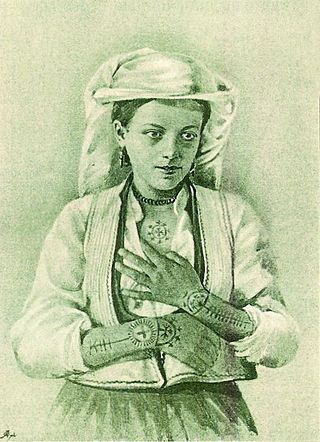Sicanje
Tattooing custom prevalent among Catholics in Ottoman Bosnia and Herzegovina From Wikipedia, the free encyclopedia
Sicanje or bocanje was a tattoo custom practiced mostly among Catholic Croat teenage girls and boys of the central regions of Bosnia and Herzegovina, as well as the Dalmatia region of Croatia.[1][2] The tattoo practice, which has been widespread among Albanians (see Albanian traditional tattooing) and also Vlach women, native populations of the western Balkans, predates the Slavic migrations to the Balkans, and consequently Christianity itself, tracing back to Illyrian times, although scholars documented it in the 19th century. The Eastern Orthodox Slavic population abhorred this practice.[3]

History
Summarize
Perspective

Tattooing of young girls and boys in Bosnia and Herzegovina is colloquially called sicanje or bocanje, and it was a widespread custom mostly among Catholic Croats in the central regions.[4] The custom is thought to predate the Slavic migration to the Balkans and even Christianity.[5][6] In the 1st century BC, the Greek historian Strabo wrote of tattooing among inhabitants of this area, namely Illyrians and Thracians,[7][8] along with other customs.[9] Until the 20th century, Albanians – Southern and Northern, Catholics and Muslims, men and women – practised tattooing, a tradition considered to have been handed down from their Illyrian ancestors.[10][11] Also Vlach women from Greece, Macedonia and Herzegovina utilized tattoos.[12] Archaeologist Ćiro Truhelka researched these types of tattoos in the late 19th century, becoming one of the first to write about them and to illustrate them.[13][14] In 1894, a Bosnian-based doctor named Leopold Glück published an article in Vienna titled Die Tätowirung der Haut bei den Katholiken Bosniens und der Herzegowina (The Tattooing of Skin Among the Catholics of Bosnia and Herzegovina) detailing the tattoos observed among the locals.[15]
Women in some parts of the country tattooed their hands and other visible parts of the body (such as brow, cheeks, wrist, or below the neck) with Christian symbols and stećak ornaments. Boys were also tattooed with the same symbols mostly above the elbow on the right arm, chest, forehead, and pointer finger. This can be seen today, not only in Bosnia and Herzegovina but among ethnic Croats from Bosnia and Herzegovina living abroad.[16][17] Children were tattooed from as early as the age of six, usually during the period between the feast of Saint Joseph in March to the feast of Saint John the Baptist in June.[18]
Designs
Summarize
Perspective

The most common symbols tattooed were the cross (križ), bracelet (narukvica), fence (ograda), and branches or twigs (grančica).[19] The cross had numerous variations, with one of the most common ones included small branch-like lines called "grančica" or "jelica" (pine tree). Bracelet-like designs were sometimes tattooed around the women's wrists, either with crosses or a fence-like motif. There were many non-Christian, or pagan symbols used, the most common consisting of circles believed to be connected to the traditional circle ("kolo") dances of the villages.[20] The pagan and Christian symbols were mixed together indiscriminately, with the first originating from nature and family in Illyrian times, and the other with later adapted Christian meaning.[20][19] The most common areas to tattoos were the arms and hands (including fingers), and on the chest and forehead.
Edith Durham, who extensively studied Balkan traditional tattooing with fieldwork research, was able to thoroughly explain the patterns of Catholic tattoos in Bosnia – especially the very common "twigs" – only after asking Albanians of Thethi–Shala for a description of all the little lines that accompanied a semicircle incised on an old gravestone. They answered that those twigs were "the light coming from the Moon, of course". For Albanians, it was the traditional way to represent light, which emanated from the Sun (Dielli) and from the Moon (Hëna), which was often represented as a crescent. So, the patterns of Catholic tattoos in Bosnia, which until then were known as "circles, semicircles, and lines or twigs", eventually were clearly explained as compounds of rayed (emanating light) suns, moons, and crosses, from an expression of nature-worship and hearth-worship.[21] Furthermore, the crosses (including swastikas) have been explained by Indo-Europeanist Karl Treimer as the symbol of the Illyrian fire god, Enji, who was the most prominent god of the Albanian pantheon in Roman times by interpreting Jupiter, when week-day names were formed in the Albanian language as Thursday (e enjte) was dedicated to him.[22]

Modern
The custom of tattooing young girls and boys died out after World War II with the establishment of the FPR Yugoslavia, and tattoos done by the traditional method are now only seen on old women.[23][24] Today, there is a growing trend of modern tattoo artists utilising the traditional designs with contemporary tattooing methods in Croatia and Bosnia and Herzegovina.[25]
In media
In 2013, a documentary titled Sicanje, bocanje, tetoviranje aired on Croatian television channel HRT 3.[24][26] In 2011, Vice published an article titled "The Croatian Tattooed Grandma Cult" about the phenomena.[27] Furthermore, Vice Serbia released a story and short film titled Tetovirane bake (Tattooed Grandmas), where they interview various Bosnian Croat women about their tattoos.[28]
See also
References
Bibliography
External links
Wikiwand - on
Seamless Wikipedia browsing. On steroids.
